
Just a few decades ago, doctors did not know about the existence of many rare diseases. With so few clinical cases to work with and limited understanding of their causes, these illnesses often went below the radar or ended up getting mistaken for something else.
The progress of medicine has been astonishing, and we are now able to classify many rare diseases and to deliver targeted treatments for some of them. Still, for many rare cancers, effective therapies remains elusive. And now researchers at The Institute of Cancer Research have suggested one possible reason for the difficulty in delivering effective treatment. What if you can’t you treat a patient because they don’t have the disease you originally thought?
A recent review paper by Dr Chris Jones, leader of the Glioma Team at the ICR, discusses the case of high-grade gliomas, a group of severe brain and spine cancers. High-grade gliomas arise in both adults and children, and in the both have an extremely low survival rate. I spoke to Dr Jones about recent discoveries in the field and their implications for glioma treatment. He explained that while adult and childhood high-grade gliomas appear to be the same on a surface level, genetic research show that they have two sets of molecular causes.
“Genome analysis of childhood high-grade gliomas samples has provided us with an unprecedented amount of genetic data” he told me. “We now have abundant evidence that there are some mutations specific to the childhood version of these tumours. The mutations appear early in development and there is active selective pressure driving the progression of these cancers. From a treatment point of view, childhood and adult high-grade gliomas are effectively different diseases, and should therefore be treated as such.”
The lesson here is that even if two diseases look the same, a more thorough examination can tell you a different story. Dr Jones enthuses about the newest genome-wide analysis techniques that allow researchers to collect new genetic data. Similar techniques can not only reveal differences between subtypes of a given cancer, but also show similarities between apparently different diseases. A previous paper by Dr Jones explained how the same mutation is involved in the development of a rare childhood brain cancer called diffuse intrinsic pontine glioma and an inherited disorder called fibrodysplasia ossificans progressiva, also known as stone man syndrome. This unexpected link means that drugs being developed to treat stone man syndrome could also potentially be used to treat diffuse intrinsic pontine glioma, which is currently incurable.
The implications of genome-wide testing are very clear: as we move towards an age of increasingly personalised medicine, the ability to scan the genetic code of patients for key mutations helps clinicians in understanding exactly which disease they are facing, and to fine-tune treatment accordingly.
comments powered by